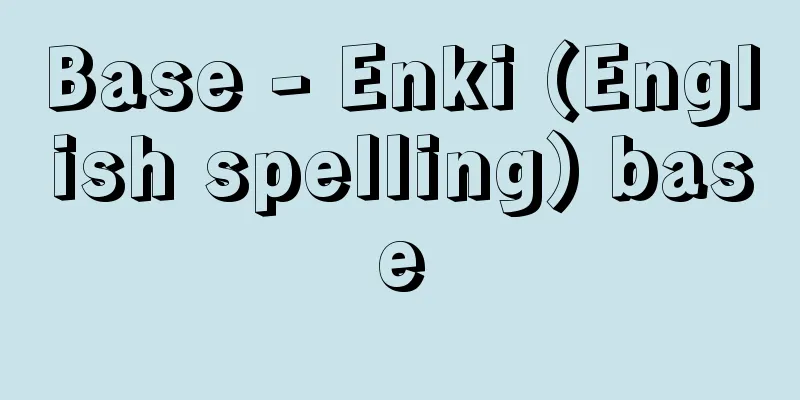Base - Enki (English spelling) base

|
A substance that has the property of neutralizing the properties of an acid. Historically, the existence of salts such as table salt was first known, followed by acids such as fruit juice and aqueous solutions of oxides. A base is the base of a salt, that is, a substance that reacts with an acid to give a salt. Potassium carbonate obtained from the ashes of terrestrial plants and sodium carbonate obtained from the ashes of seaweed were called alkalis, from the Arabic word kali, which means ash, and their intense chemical reactivity that attacks metals and organic matter is due to their basicity. The terms alkali and base are used interchangeably, but base is a more appropriate term to generally describe chemical properties. Bases are a complementary concept to acids, and in 1884, S. A. Arrhenius of Sweden defined a substance that dissolves in water and releases hydroxide ions (OH- ) as a base, and a substance that releases hydrogen ions (H +) as an acid. Bases are classified as monoacids, diacids, etc., depending on the number of hydroxyl groups (-OH) contained in the chemical formula. Sodium hydroxide (NaOH) and potassium hydroxide (KOH) are monoacids, calcium hydroxide (Ca(OH) 2 ) and barium hydroxide (Ba(OH) 2) are diacids, and aluminum hydroxide (Al(OH) 3) is a triacid. Pyridine C5H5N and ammonia NH3 , which do not have a hydroxyl group, are also soluble in water and are basic because they react with water to release hydroxide ions. C 5 H 5 N+H 2 OC 5 H 5 NH + +OH - [Iwamoto Shinbu] "Acids and Bases" by Kunihiko Mizumachi (2003, Shokabo) " ▽ "30 Lectures on Acids and Bases" by Akira Yamazaki (2014, Asakura Shoten) [References] | | | | | |Source: Shogakukan Encyclopedia Nipponica About Encyclopedia Nipponica Information | Legend |
|
酸の性質を打ち消す性質をもつ物質。歴史的にみると、まず食塩のような塩の存在が知られ、ついで果汁や酸化物水溶液の酸が知られるようになった。塩基とは、塩の基(もと)、すなわち酸と反応して塩を与える物質である。陸生植物の灰から得られる炭酸カリウムや、海草の灰から得られる炭酸ナトリウムは、灰を意味するアラビア語kaliからアルカリalkaliとよばれたが、金属や有機物を侵す激しい化学反応性はその塩基性によるものである。アルカリと塩基はほとんど同じ意味に用いられているが、化学的性質を一般的に表現する用語としては塩基が適当である。 塩基は酸と相補的に成立する概念であり、1884年にスウェーデンのS・A・アレニウスは、水に溶けて水酸化物イオンOH-を放出する物質を塩基、水素イオンH+を放出する物質を酸と定義した。化学式中に含まれるヒドロキシ基-OHの数によって、一酸塩基、二酸塩基、……とよぶ塩基の分類法がある。水酸化ナトリウムNaOH、水酸化カリウムKOHは一酸塩基であり、水酸化カルシウムCa(OH)2、水酸化バリウムBa(OH)2は二酸塩基、水酸化アルミニウムAl(OH)3は三酸塩基である。 ヒドロキシ基をもたないピリジンC5H5NやアンモニアNH3も水に溶けて塩基性を示す。その原因は、水と反応して水酸化物イオンを放出することにある。 C5H5N+H2OC5H5NH++OH- [岩本振武] 『水町邦彦著『酸と塩基』(2003・裳華房)』▽『山崎昶著『酸と塩基30講』(2014・朝倉書店)』 [参照項目] | | | | | |出典 小学館 日本大百科全書(ニッポニカ)日本大百科全書(ニッポニカ)について 情報 | 凡例 |
Recommend
Omphalodes japonica (English name) Omphalodes japonica
…[Tetsuichi Yahara]. … *Some of the terminology t...
Kidney (English spelling)
Flint nodule [Arkell & Tomkeieff: 1953]. Kidne...
Rifleman
...All species have a thin, pointed beak. The rif...
Busbecq, OGde (English spelling) BusbecqOGde
… [Nakajikazu] [history] The name tulip is said t...
Shimazu Hisamitsu
Year of death: December 6, 1887 Year of birth: Bun...
Tact
〘noun〙 (Takt・tact) ① rhythm. ※Taijoubutsushin (192...
Takanobu Kano
Year of death: 4th August 30th, Genna (1618.10.18)...
Ion exchange resin
A type of substance that exhibits ion exchange pr...
Lantien man (English spelling)
A Chinese fossil human. A mandible and skull frag...
debris avalanche
...This causes great disasters at the foot of the...
Yield Point - Koufukuten
The point where deformation begins when stress ex...
Xun Yue
A scholar from the late Eastern Han Dynasty in Ch...
Shion
〘Noun〙 Buddhist term. Four kinds of kindness that ...
Verstand
…The translation of rational has been “rational” ...
Muscle tissue
Muscle tissue is a tissue formed by the accumulati...









